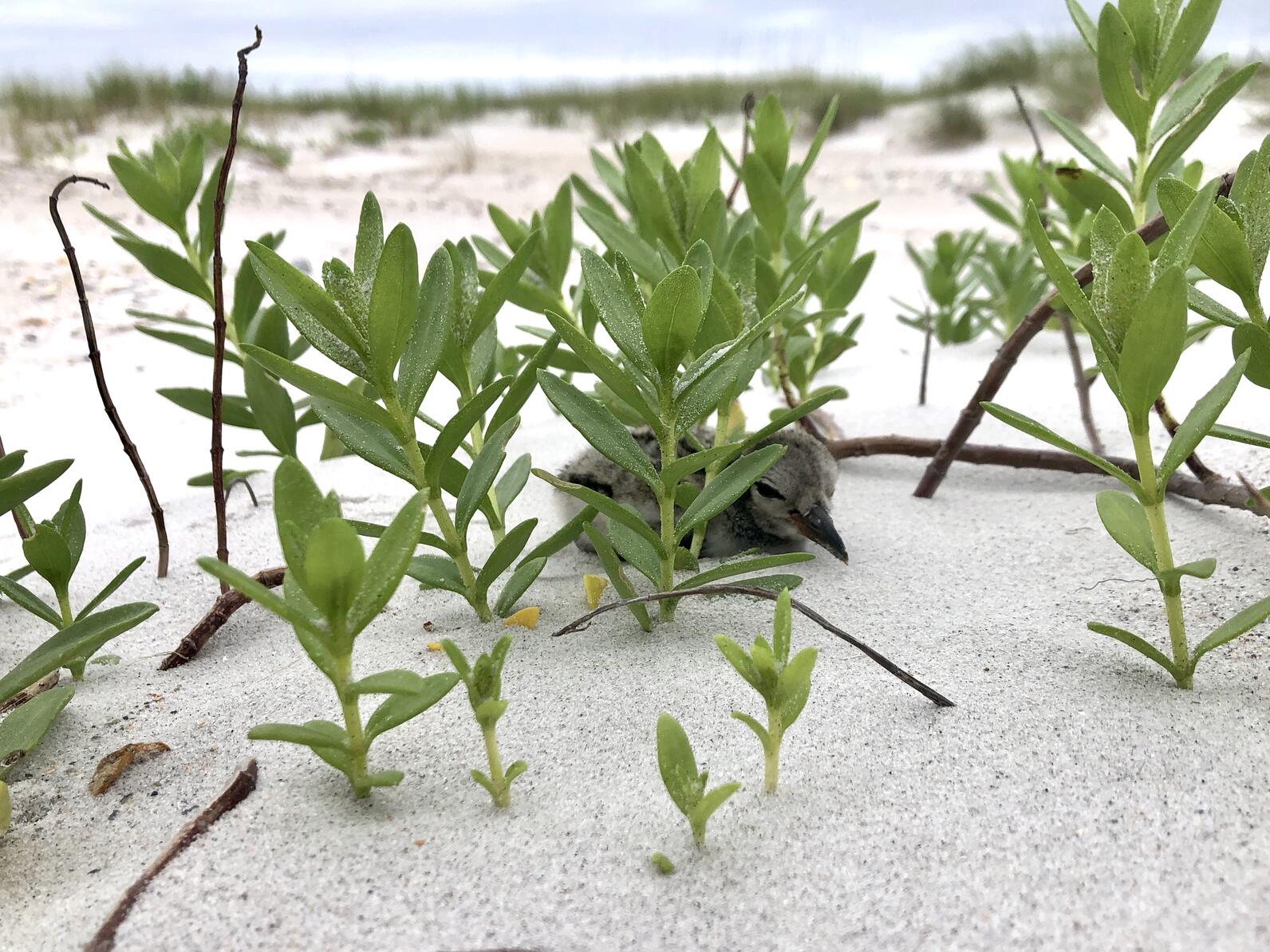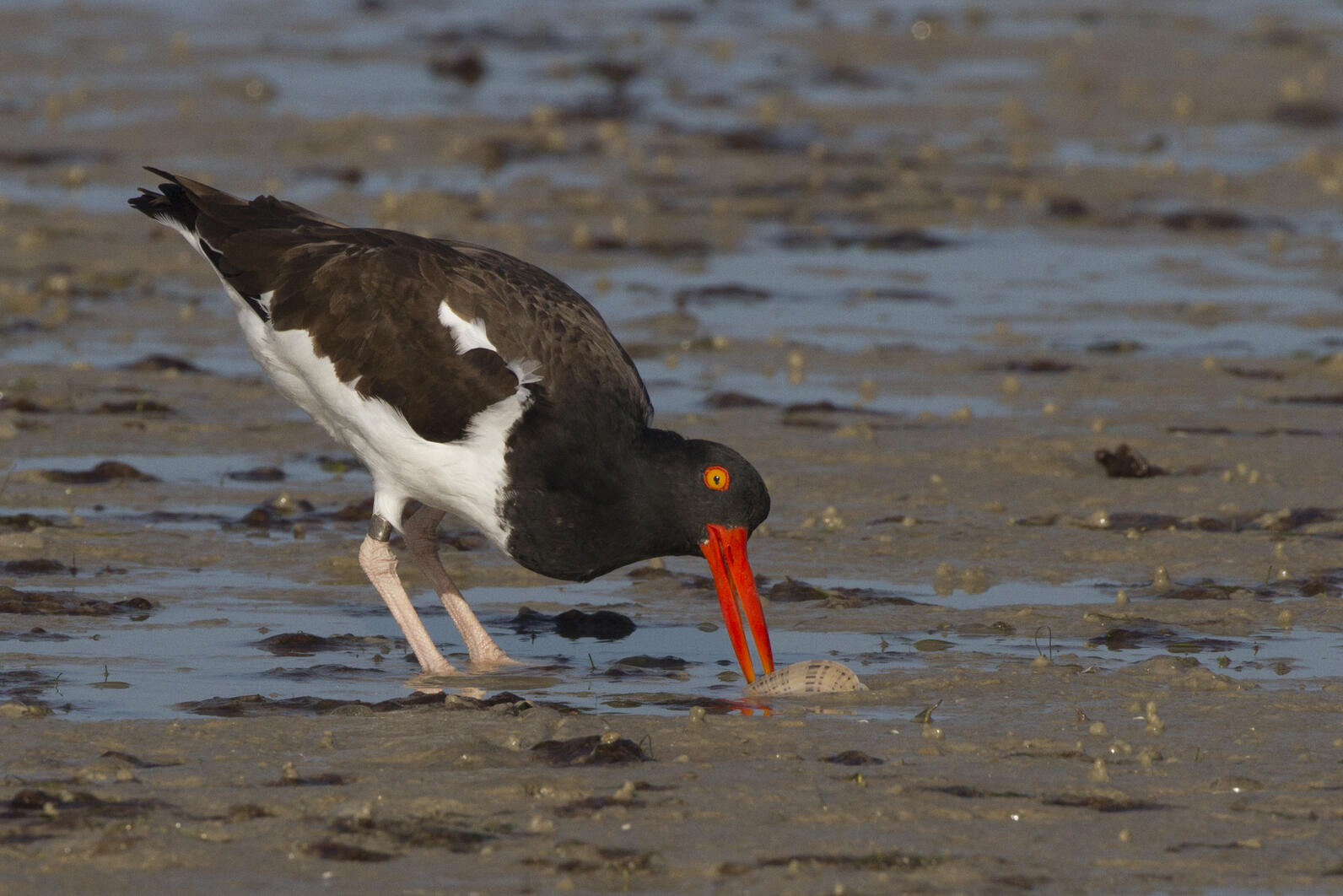DURHAM, NC (Nov. 19, 2020) - Nothing is normal in 2020, but thanks to early work by Audubon biologists, birds on the North Carolina coast were able to survive and thrive this nesting season.
Pelicans, plovers, and a host of other coastal birds began nesting in the spring, just as the state’s stay-home order went into effect. Fortunately, our staff was able to mobilize quickly.
They ventured out before the lockdown, traveling by boat to undeveloped beaches and islands to post all of our usual nesting areas from Pamlico Sound to the Wilmington area.
Just like humans during the pandemic, birds need social distancing too. The signs our staff install are one of the best ways to keep beachgoers and their pets a safe distance from nesting birds, ensuring they have the space they need to lay eggs and raise chicks.
“A trip to the beach wouldn’t be the same without Black Skimmers gliding by or Brown Pelicans patrolling the waves," said Lindsay Addison, coastal biologist at Audubon North Carolina. "This on-the-ground conservation work ensures these birds continue to have a home on our coast, despite all the pressures they face.”
Despite a hurricane in August, many bird species had successful nesting seasons, due in large part to the sanctuary space reserved for them. By posting and monitoring these nesting areas, Audubon protects and provides habitat for 40 percent of North Carolina’s coastal nesting birds.
Among these were nearly half of North Carolina’s breeding Brown Pelicans and the state’s largest nesting colonies of Least Terns and Black Skimmers, located at Lea-Hutaff Island and the south end of Wrightsville Beach, respectively.
Coastal birds continue to face threats on all sides, from encroaching development to sea level rise and more frequent hurricanes. By protecting the places these birds need, Audubon is ensuring their populations remain resilient.
Like everything this year, our coastal sanctuary work didn’t completely escape the fallout of the pandemic. We missed the dedicated team of beach bird stewards who volunteer to help with posting and monitoring and look forward to working with them again.
Surviving the Storm
The most dramatic event of the 2020 nesting season occurred in early August, when Hurricane Isaias lashed southern portions of the North Carolina coast with heavy winds and a powerful storm surge.
Audubon staff made it through the storm safely and were able to assess damage shortly after the fast-moving storm departed. Fortunately, many bird species had already fledged their young, meaning their chicks were old enough to weather the storm. Species that hatched chicks later fared worse.
At the sanctuary at the south end of Wrightsville Beach, storm surge wiped out roughly half of the 60 newly hatched Black Skimmer chicks. Young birds that were a bit older were able to survive, including one skimmer we found that had its wing wrapped in strands of sea oats during the storm. A week later, we re-found the bird—a skimmer known as “E0” because of the band on its leg—and were thrilled to see it had recovered and was flying once again.
Like many coastal species, skimmers face multiple threats from changes to our climate, from more intense storms to other factors, like sea level rise and heavier rain. For skimmers at Wrightsville Beach, many pairs nested late in the season because their first nests failed in May due to heavy rain. These were the same birds who lost chicks to Isaias.
But elsewhere, birds were resilient in the face of the storm. On the Cape Fear River, a tornado touched down on Battery Island, where as many as 20,000 White Ibis breed and nest. The good news is that hundreds of young ibis fledglings were still present on the island in the days after the storm.
Black Skimmer Banding Reveals New Insights
Audubon North Carolina biologists are in the second year of a skimmer banding project that is already revealing new things about these gregarious coastal birds. Last year, staff and our partners banded more than 100 skimmers, attaching tiny black bands to their legs so they can be identified later, no matter where they are. This year, we banded more than 100 additional chicks at Wrightsville Beach and at one of the NC Wildlife Resources Commission’s sites in Pamlico Sound.
About half of the 2019 cohort have already been spotted again, and this year’s chicks are now being found as far away as Everglades National Park in Florida. Banding also helps us learn about skimmers closer to home. We were able to re-identify the chick trapped by sea oats during Isaias because of the band on its leg.
American Oystercatchers on Lea-Hutaff Island
American Oystercatchers had one of their most successful breeding seasons on record this summer at Lea-Hutaff Island, a 5,641-acre barrier island protected and managed by Audubon. Twenty-five breeding couples successfully fledged 12 chicks on the island, including a pair of brand new parents.
We know this thanks to an ongoing bird banding project by Audubon biologists. One of the parents that fledged babies this summer was a bird banded by Audubon biologists in 2016. After checking band records, we discovered that this summer was the first time the bird was seen nesting—meaning it was successful on its first attempt! This bird, band code CWA, was doubly special because fledged from Masonboro Island, one of our partner’s sites, and our current Lea-Hutaff biological technician Anna Parot had banded it in 2016 during her first year of coastal bird work.


New Sea Turtle Nest
Sea turtle nesting numbers remained steady on Lea-Hutaff Island at 19 confirmed nests, including the island’s first recorded green sea turtle nest. The remaining nests were all from loggerhead sea turtles.
Nests that hatched by late August generally did well, despite Hurricane Isaias. However, a high-tide event brought by the offshore passage of Hurricane Teddy and lunar tides caused the last seven nests to fail. In all, just over 1,000 hatchlings are known to have made it into the Atlantic Ocean.
Significant Flocks of Terns, Pelicans Raise Chicks at Audubon Sites
While the pandemic prevented complete counts for some species of coastal nesting waterbirds, preliminary numbers are in for others, including Black Skimmers, Least Terns, and Brown Pelicans.
The south end of Wrightsville Beach ended up with the largest Black Skimmer colony in the state this year, at 134 pairs. It fledged over 100 chicks, making it successful as well.
The skimmers were joined by a small group of Gull-billed Terns which are a state species of Greatest Conservation Need. Five pairs fledged chicks, the first time in over a decade that a beach in southeastern North Carolina successfully produced new Gull-billed Terns.
Meanwhile, Lea-Hutaff Island again hosted the largest Least Tern colony in the state, representing about a third of North Carolina’s population. Over 1,000 pairs made the island their home.
Finally, 1,800 pairs of Brown Pelicans nested on the Cape Fear River islands. These, plus another 251 pairs on Audubon’s Beacon Island in Ocracoke Inlet made up over 40 percent of the state’s nesting pelicans.
Media contact: Ben Graham, ben.graham@audubon.org, 919-880-3793
About Audubon
The National Audubon Society protects birds and the places they need, today and tomorrow. A nonprofit conservation organization since 1905, Audubon works throughout the Americas using science, advocacy, education, and on-the-ground conservation. Learn more at www.audubon.org and on Facebook, Twitter and Instagram @audubonsociety.
About Audubon North Carolina
Audubon North Carolina, a state program of the National Audubon Society, has offices in Durham, Boone, Corolla, and Wilmington. Learn more at www.nc.audubon.org and on Twitter, Facebook, and Instagram.









